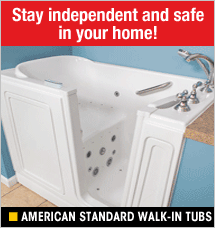Health, Wellness & the Good Life
The Ins and Outs of Walk-In Tubs

The ads are so inviting, taking a bath again when a person can't easily use their home's bathtub. It looks so easy.
But seriously considering a walk-in tub a bathtub with a door that closes so the user can sit and soak in water rather than just take a shower can be an intimidating process. Internet searches generally link you to manufacturers and vendors sales-pitching you on their particular product. They may even want to come into your home.
Nevertheless, it may well be worth pursuing because these tubs might make all the difference in enabling older folks, people with disabilities, arthritis or chronic pain, and obese persons to bathe safely and hence remain in a home they love.
Unfortunately, there are not many showrooms where you can take a tub for a "test drive" so you must be careful in your research. (If possible, ask friends if they know anyone with such a tub and put on your swimsuit to try it out.)
What Are These Tubs Like?
These days, most walk-ins are molded from gel-coat fiberglass. "Marine-grade" fiberglass is considered the most durable, while cheaper products can eventually get cracks and leaks. Tubs come in two styles – framed or frameless. The former is built on a steel frame and typically has a 6- to 12-inch threshold. Frameless styles use an extra-strength mold, rest directly on your floor, and generally drain faster. Their typical threshold is 3 inches or less. Your choice may depend partly on your home's existing construction.
Tubs generally vary from about three to four feet in depth and fill to about 2 feet. The other dimensions can vary, but start at 2.5 feet in length. Features typically include a molded seat, often with a non-slip surface, two or more grab bars and non-slip floors. Hand-held shower heads, often on an adjustable slide-bar are also popular.
Doors open either in or out. An inward-opening door will require less space, while outward-opening doors may be more convenient for persons who use wheelchairs or need the assistance of another person.
Of course, the user must sit in the tub, first while it fills, then until it's empty and the door can be opened, so a significant consideration is filling and draining time. Some tubs can take up to 15 minutes while the user must sit, wait, and possibly shiver. Part of the wait depends on the home's existing plumbing system. Generally, though, times range from 2-3 minutes.
Extras?
As tubs get more expensive, they will generally be of better quality and have extra features beyond simply soaking. There may be air jets or water jets (or both!) and the hydrotherapy of those fairly forceful jets can soothe aches and pains as well as being just plain relaxing. Hydrotherapy has been shown to benefit arthritis, depression, insomnia, diabetic symptoms, help regenerate injured body tissue and can be just plain fun. Some tubs even offer diffusers to dispense oils for aroma therapy.
Since the tubs don't use chlorine or other purifying chemicals in the bath water, it's important to have a system to keep bacteria and mold from forming in the hydrotherapy jets. Some ozone cleaning systems are very effective.
Anti-scald valves can prevent the water from becoming too hot, while in-line heaters on hydrotherapy jets keep the water pleasantly warm.
How Much Do Walk-in Tubs Cost?
Always remember when it comes to these tubs, older folks are seen as prime marketing opportunities – otherwise known as hot prospects – so be cautious. Treat this purchase as you would buying a used car and don't believe everything you're told. How much does installation really cost? How long does it really take to fill? To drain? Will the salesperson put those claims in writing?
Prices vary widely depending on quality and extra features. Basic models start around $2500 or $3000 while better models with extras can run up to $10,000 or more. In some cases, you might need to upgrade an existing water heater and possibly remodel an existing bathroom.
If you are confident about large purchases and are willing to arrange for installation, you might consider a home improvement store such as Lowe's or Home Depot. (Remember, Lowe's offers a 10 percent discount and Home Depot offers a 10 percent discount up to $500 for persons with valid military ID cards.)
Installation requires plumbing and electrical work and sometimes carpentry as well. It's usually better to use a single contractor, but not necessarily the one recommended by the tub vendor. On the other hand, not every plumber may have walk-in tub experience. Check that the contractor is licensed and insured.
Some vendors are quite competitive, especially with high-value tubs, and have considerable leeway in their pricing. You may be able to negotiate items like shipping, delivery, and installation. Get a clear contract with everything in writing – especially the warranty.
Warranties can range from a year to a lifetime. The most important guarantee is the door seal, of course, but also pumps, heaters, and jets. Ensure the company has been in business for a while – and you've heard this before – check the business with your local Better Business Bureau.
Lynn Pribus lives near Charlottesville, Virginia.




























































